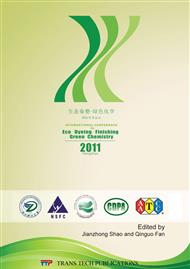p.452
p.457
p.462
p.466
p.473
p.478
p.484
p.489
p.494
Synthesis of Polystyrene-b-poly(n-butyl acrylate)-b-Polystyrene Triblock Copolymers as Binder for Pigment Dyeing
Abstract:
Well-controlled polystyrene-b-poly (n-butyl acrylate)-b-polystyrene (PSt-b-PnBA-b-PSt) triblock copolymers were prepared by RAFT (reversible addition-fragmentation chain transfer) emulsion polymerization process. The mechanical properties of the triblock copolymers were investigated in comparison to the P(nBA-co-St) statistical copolymers. When the PSt content is 20%, the ultimate tensile strength of triblock copolymer is nearly six times the strength of statistical copolymer, while their modulus are all around 3.0×103 Pa. The triblock copolymer films feel smooth and non-tacky as the PSt content is higher than 20%. It indicates that PSt-b-PnBA-b-PSt triblock copolymers can be used as binders in pigment dyeing, providing the dyed fabrics with soft non-tacky handle and good fastness properties.
Info:
Periodical:
Pages:
473-477
Citation:
Online since:
January 2012
Authors:
Price:
Сopyright:
© 2012 Trans Tech Publications Ltd. All Rights Reserved
Share:
Citation:


